 BUILT Images / Blend Images / Adobe Stock
BUILT Images / Blend Images / Adobe Stock
Stucco and Exterior Insulation and Finish System (EIFS) (also called synthetic stucco) are both aesthetically pleasing, long-lasting options for coating the exterior of your home. While they may look similar, homeowners should be aware of some key differences between the two.
The biggest differences between EIFS and traditional stucco are their constituent ingredients and application methods.
EIFS consists of synthetic materials applied in several coats over rigid foam insulation and a fiberglass mesh. On the other hand, traditional stucco comprises a mix of natural ingredients like Portland cement, sand, and lime applied in two to three layers over a metal lath on a sheathing.
On This Page:
- What Is EIFS?
- What Is Stucco?
- Appearance
- Cost
- Upkeep
- Durability
- Installation
- Environmental Impact
- Resale Value
- Is EIFS or Stucco Better for Your Home?
- EIFS and Stucco vs. Other Options
What Is EIFS?
 MAXFX / Adobe Stock
MAXFX / Adobe Stock
Exterior Insulation and Finish System (EIFS) is a type of wall finishing system consisting of several layers, including an optional water-resistant barrier that covers the substrate, a form-insulation board, fiberglass mesh, a water-resistant base coat, and a finish coat. Some people also refer to EIFS as Dryvit, though Dryvit is not an actual product but rather the brand name of a company that manufactures EIFS products.
The outer layer of an EIFS siding is an acrylic finish coat that furnishes the material’s texture and protects the inner layers. The base coat (usually cement mixed with acrylic polymer) sits beneath the outer layer and contains a fiberglass mesh embedded in it. This layer strengthens the finish’s impact resistance. The insulation board—which lies below the base coat and is typically made of expanded polystyrene—provides added insulation.
Synthetic stucco is 80% lighter than traditional stucco and is relatively durable because it contains fiberglass. It also boasts an R-value (the ability to resist heat flow) between 4 and 5.6, making it a great choice for homes in cold climates. By comparison, the R-value of regular stucco is just 0.20.
EIFS, while water-resistant, is not waterproof, however. If water gets under the system, it can cause issues like rot and mold.
What Is Stucco?
 oxanas / Adobe Stock
oxanas / Adobe Stock
Traditional stucco is a cement-based plaster that contains a mixture of Portland cement, lime, sand, and water. Stucco is typically applied in three coats: a rough scratch coat, a secondary base coat, and a finish coat.
The scratch coat is the first layer and provides a strong base for the system. You don’t need a scratch coat if you apply stucco over a brick or concrete wall. The secondary base coat, also known as the brown coat, provides an even surface for the finish coat to adhere to. The finish coat is a decorative coat, and you can color it to give your finish the look you want.
You typically apply the three coats of stucco to a metal lath or reinforcement secured to a wall over building paper, including felt paper, sheathing paper, or building felt. You can protect the edges with metal trim pieces. The metal lath provides structural support for the stucco, while the building paper acts as a second barrier against water (which gets through joints or cracks in the stucco membranes), separates the stucco from the structure itself, and helps embed the stucco mix in the metal lath. Rough masonry surfaces, such as concrete, don’t require lath or building paper—you can apply stucco directly to the wall surface.
Properly installed stucco is durable and long-lasting. However, it can be susceptible to surface cracking.
Start Your Siding Project TodayAppearance
EIFS is visually indistinguishable from traditional stucco when viewed from a distance. One way to tell the difference between the two finishes is to knock on them. If your wall finish sounds hollow, it’s most likely EIFS. If it’s hard and solid, it’s likely traditional stucco. A close examination will also reveal some texture differences between the two finishes.
| EIFS | Traditional Stucco |
|---|---|
| Available in more colors | Limited color options |
| Has a smoother texture | Has a rougher texture than EIFS |
EIFS
You can color and texturize EIFS to mimic the appearance of traditional stucco, brick, or other building materials, giving it greater versatility in terms of appearance. You can get EIFS in almost any color you want. This finish also has a relatively smoother texture than traditional stucco.
Traditional Stucco
Since it’s a cement-based product, there are limitations to the colors you can get with this traditional stucco. The colors available are less vibrant than those of synthetic stucco. Traditional stucco also has a rougher texture than synthetic stucco.
Cost
EIFS is somewhat more time-consuming to install, so the overall installation costs for this finish tend to be higher than those of traditional stucco. However, EIFS has lower lifetime costs (including maintenance and repair) and also lasts longer. This makes it more cost-effective over the long term.
| EIFS | Traditional Stucco |
|---|---|
| $8 – $14 per sq. ft., fully installed | $7 – $9 per sq. ft., fully installed |
EIFS
EIFS costs between $8 and $14 per square foot of wall space, fully installed. For a standard home with 1,500 square feet of siding, this translates to between $12,000 and $21,000.
Traditional Stucco
Traditional stucco costs between $7 and $9 per square foot, fully installed. So, for a house with 1,500 square feet of wall space, the cost of installing traditional stucco will be between $10,500 and $13,500.
That said, the cost to stucco a house (whether traditional stucco or EIFS) can vary widely depending on your exact location, time of year, and the contractor you hire to do the job.
Upkeep
Synthetic stucco is generally less of a headache when it comes to ongoing siding maintenance. Both types of finishes, however, require regular inspection and cleaning. Avoid power washing for both materials. For traditional stucco, power washing can lead to cracks. In the case of EIFS, pressure washing can force water behind the finish and lead to mold and rot, among other problems, if there’s no drainage system within your wall.
| EIFS | Traditional Stucco |
|---|---|
| Requires less maintenance other than regular cleaning | More maintenance requirements, including caulking, patching, and even repainting, to maintain its good condition and appearance |
EIFS
EIFS doesn’t need repainting since the color runs through the material. The acrylic binder used in the system ensures resistance to fading, chalking, and yellowing. EIFS is also simple to clean, requiring only a low-pressure wash and a manufacturer-approved detergent.
Traditional Stucco
Traditional stucco has cement-based makeup. This makes it prone to cracking and means that it will require more regular maintenance, including caulking and patching, to keep it in good condition and maintain its appearance. Furthermore, if damage occurs to this finish, you may need to repair the entire surface. Stucco repair costs between $600 and $2,500. If you need to repaint, stucco repainting costs between $1.80 and $3.60 per square foot.
Still Have Questions About Your Siding Project?Durability
Both traditional stucco and EIFS are quite durable. EIFS, however, has a slight advantage because of the inclusion of a fiberglass layer that provides more durability even in harsh weather conditions like hurricane-force winds.
| EIFS | Traditional Stucco |
|---|---|
| Resistant to cracking | Prone to cracking over time |
| Can trap moisture behind the finish leading to mold and rot | Is porous in nature and thus allows moisture to move both in and out as necessary. |
EIFS
Synthetic stucco is highly resistant to cracks and crumbling resulting from shifting foundations, thermal expansion, or freeze/thaw cycles. One disadvantage of EIFS, however, is that it’s non-porous and thus tends to trap moisture if it gets behind the system. You, therefore, need to integrate a drainage system into your wall. Otherwise, moisture can slowly build up and lead to wall damage. By contrast, traditional stucco is “breathable” in nature, permitting moisture to move both into and out of the wall cavity.
Traditional Stucco
Traditional stucco is highly resistant to termite infestations, rot, and mold. However, the material tends to buckle in extreme weather. Repeated freeze and thaw cycles in cold weather, for example, can lead to the gradual disintegration of the material.
Installation
Installing EIFS is more complex and time-consuming than traditional stucco. While you can install traditional stucco DIY, let professionals handle your EIFS installation.
| EIFS | Traditional Stucco |
|---|---|
| Needs professional installation | DIY installation is possible |
EIFS
Installing EIFS is more difficult and time-consuming. This is because there are many layers to install, some of which must dry before applying others on top. This type of finish also carries a high risk of error. Proper installation is necessary to avoid water intrusion, which can lead to issues like mold and rot down the road. This is why it’s best to leave EIFS installation to professionals.
Traditional Stucco
Handy homeowners can apply traditional stucco DIY. This can help you save on labor costs. But if you’re unsure of your ability to correctly apply the finish, hire a local stucco contractor to ensure correct installation.
Environmental Impact
Neither traditional stucco nor synthetic stucco is exactly environmentally friendly. For a more eco-friendly wall finish, you can go for wood, stone, or stone veneer siding.
| EIFS | Traditional Stucco |
|---|---|
| The acrylic in EIFS is a petroleum product, which is non-renewable | Portland cement production is energy intensive and emits pollutants |
EIFS
The acrylic used in EIFS comes from petroleum, which is non-renewable and non-recyclable.
Traditional Stucco
One of the chief ingredients of traditional stucco is Portland cement. The manufacture of this ingredient is energy intensive and also emits large amounts of CO2 and other pollutants. These factors lower the overall environmental friendliness of this finish.
Resale Value
Both EIFS and traditional stucco protect your home from the elements and can boost its resale value. The ROI for both types of finishes is roughly the same (around 70%). So, when comparing EIFS siding versus stucco, choose the finish that best meets your current needs and preferences, even if you plan to sell your home later.
Is EIFS or Stucco Better for Your Home?
Both traditional stucco and synthetic stucco have their pros and cons. Neither is completely superior to the other. The best choice for your home will depend on the climate in which you live, the style and design of your home, your budget, and your personal preferences. Use the table below to compare the two options and determine the best for your home.
| Factor | EIFS | Traditional Stucco |
|---|---|---|
| Appearance | More color options and smoother texture | Fewer color options and rougher texture |
| Cost | $8 – $14 per sq. ft., fully installed | $7 – $9 per sq. ft., fully installed |
| Upkeep | No major maintenance requirements other than regular cleaning | More maintenance requirements including patching, caulking, and repainting |
| Durability | Resistant to cracking, but can trap moisture behind the finish | Prone to cracking but more “breathable” (allows in and out movement of moisture) |
| Installation | Needs installation by a professional | Possible to install DIY |
| Environmental impact | Petroleum-based and therefore not renewable | Manufacture of Portland cement, one of the core ingredients is energy intensive and releases high amounts of CO2 |
| Resale value | About 70% return on investment (ROI) | About 70% ROI (same as EIFS) |
EIFS and Stucco vs. Other Options
When comparing siding materials, stucco and EIFS are just two of many options. You may find another option, such as traditional wooden siding, more suitable for your home and budget. If unsure which is the best choice for your home, contact a local home exterior professional to discuss your options.
Vs. Vinyl siding
Vinyl siding consists of PVC plastic resin boards. It’s treated to resist mildew, rot, and chipping. Vinyl siding is cost-effective, easy to install, and available in many colors. However, it can warp and melt in hot climates.
Vs. Concrete Siding
Concrete siding, also known as fiber cement siding, is another great option for homeowners. It can work under any climate and also does a better job of resisting moisture. Though it still contains Portland cement, whose production can be energy intensive, its long life and durability mean that it’s less likely to need replacement sooner and thus less likely to end up in landfills.
Vs. Wood Siding
Wooden siding is a popular choice for homeowners who want a traditional look. While many suitable wood varieties exist, cedar and redwood are common because they’re resistant to decay. Wood siding is quick and easy to install, and replacing a damaged board is simple. Wood is renewable and biodegradable, so it’s an environmentally friendly choice if sourced sustainably.
Consult With a Siding Pro Today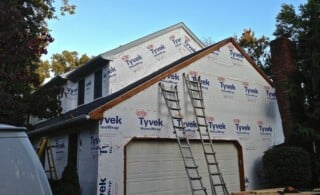 Siding Replacement: What to Expect
Siding Replacement: What to Expect 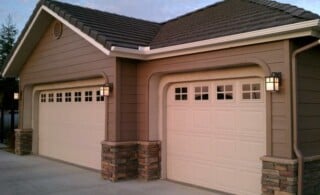 Masonite Siding: A Strong Alternative
Masonite Siding: A Strong Alternative 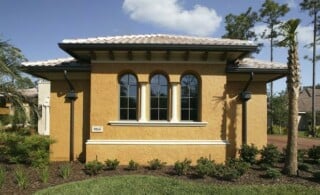 Stucco Siding – Installation Considerations & Advantages
Stucco Siding – Installation Considerations & Advantages 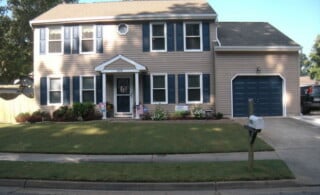 How to Maintain Different Types of Siding
How to Maintain Different Types of Siding 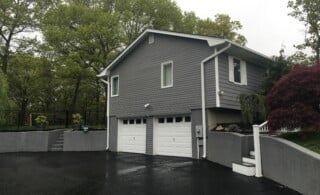 Liquid Siding – Worth a Look?
Liquid Siding – Worth a Look? 

Hello , I have a 1750 sq. ft. house , how much would I be looking at to stucco the house , house has siding on it now . Thanks
My home is stucco now but it needs lots of repairs to the stucco due to hail and high winds. Mostly war would and tare. What would be the easyst way to fix it and where can I get some of this product. My house is is around 1600 square thanks
Hi Johnny. Consider consulting our Cost Guide for Stucco Repair information and prices, or this guide with some small tips on stucco repair. Consulting a professional may be the best way to get the information you need specific to your home.
Hi, almost 40 years on the tools and 28 years (and counting) as a stucco contractor. EIFS (Synthetic Stucco) actually absorbs less water that C/S (Conventional Stucco) when applied correctly. The issues that arised with EIFS and moisture problems were because of application errors, omitted flashings/sealant joints etc. We do both systems so we are unbiased in our professional opinion based on experience. The other issue with EIFS was the impact factor, it is more easily damaged as the thickness of the coatings are approx 3/16″ to 1/4″ with EPS foam backing. Woodpeckers loved it as it reminded them of pecking on a rotted tree, the best solution to prevent such damage is to apply a layer of 20oz heavy duty reinforce fiberglass mesh designed for hi-impact situations, this is then followed up with the standard 4.5 oz mesh as required by the EIFS industry. Bottom line, both systems perform wonderfully when properly installed by professionals.
Can synthetic stucco be applied over traditional stucco for a whole home re-stucco job?
Thanks
My Idaho home has an EIFS stucco exterior that is 25 years old. The outer stucco coating has peeled off along the bottom 1-1 1/2 inches of the walls in numerous places revealing the asbestos and inner metal core enclosing styrofoam. Is there something available to patch this with? Is there a risk of water absorption if it is not sealed? Thank you
Can traditional stucco, if I add a new layer of twisted chicken wire, be put on top of synthetic stucco. I currently have synthetic and hate it. I want traditional stucco. Thanks